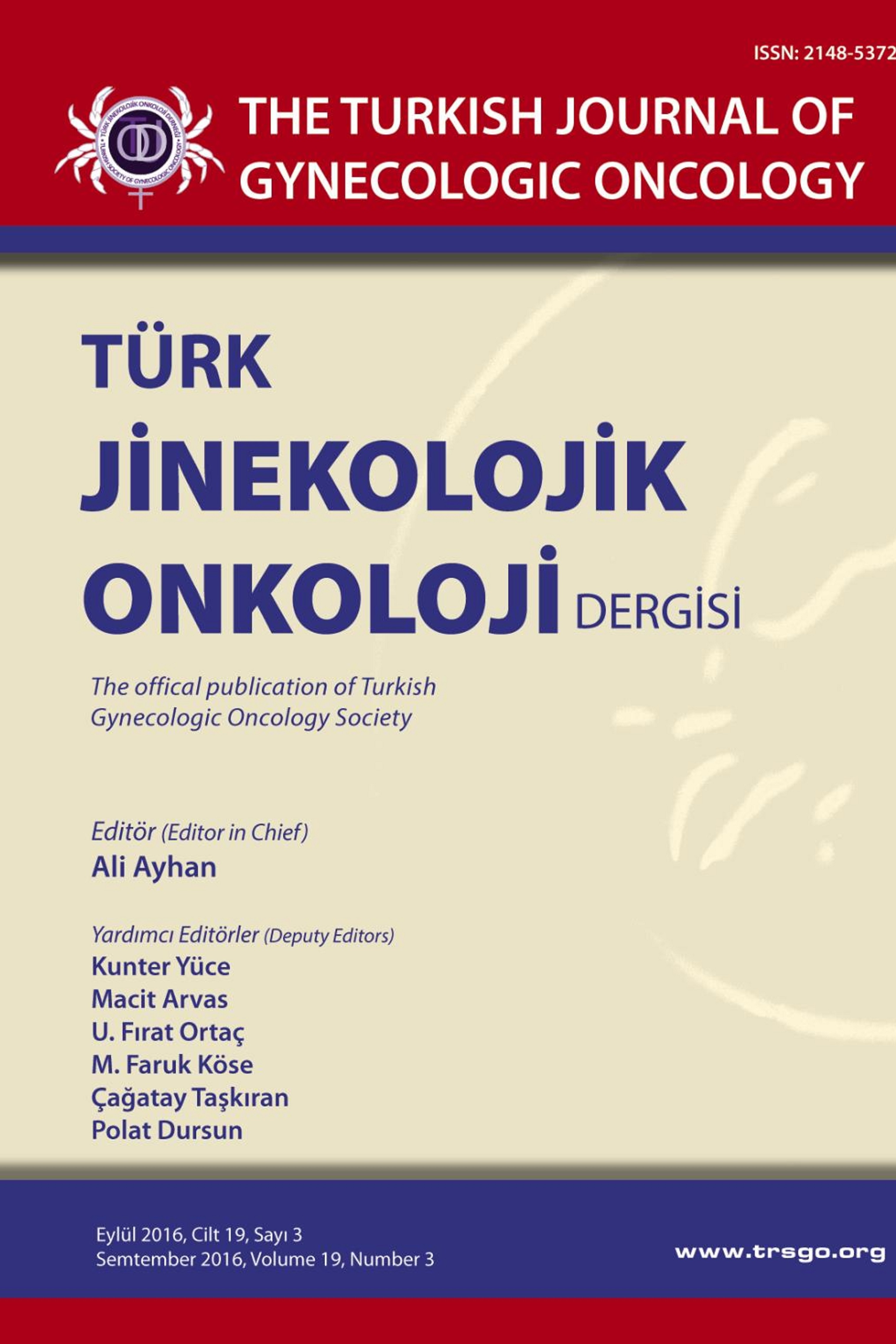LOKAL İLERİ EVRE ENDOMETRİUM KANSERİNDE ADJUVAN RADYOTERAPİ: TEDAVİ SONUÇLARI VE PROGNOSTİK FAKTÖRLER
Amaç: Lokal ileri evre endometrium kanseri tanısı ile adjuvan radyoterapi uygulanan olgular özellikleri, tedavi sonuçları ve prognostik faktörler açısından değerlendirilmiştir. Materyal ve Metot: Ege Üniversitesi Tıp Fakültesi Radyasyon Onkolojisi Anabilim Dalında 1997-2005 yılları arasında evre 34 endometrium kanseri tanısı ile postoperatif radyoterapi gören 83 olgu ret-rospektif olarak incelenmiştir. Olgulara total abdominal histerektomi ve bilateral salpingoooferektomi (ATH+BSO) uygulanmış olup 53 olguya (%63.9) lenfadenektomi, 6 olguya (%7.2) subtotal omentektomi yapılmıştır. Tüm olgulara medyan 50.4 Gy (aralık: 45-46.8 Gy) ekster-nal radyoterapi ve intrakaviter brakiterapi uygulanmıştır. Kemotera-pi 43 olguya (%51.8) radyoterapi öncesi veya sonrasında verilmiş olup sadece 4 olguda (%4.8) megestrol asetat kullanılmıştır. Bulgular: Medyan yaş 59 (aralık:31-77) olup evrelere göre dağılım: IIIA 41 (%49.4), IIIB 3 (%3.6), IIIC 35 (%42.2), IVA 4 (%4.8) olgudur. Olguların 57si (%68.7) adenokarsinom, 24ü (%28.9) non-adenokarsinom, 2si (2.4%) adenosquamöz karsinom histopatolojisindedir. Medyan takip süresi 62 ay (aralık: 5-130 ay) dır. Beş yıllık lokal kontrol, genel ve hastalıksız sağkalım oranları sırasıyla %66.2, %56 ve %46.2 olup olguların 26sında (%31.3) lokal nüks, 11inde (%13.2) uzak metastaz saptanmıştır. Tek değişkenli analizde ekstrauterin hastalık sayısının 3ten fazla olması (p=0.005) ve servikal stromal uzanımın (p=0.05) genel sağkalım üzerine, histolojik derecenin (p=0.032) ve ekstrauterin hastalık sayısının 3ten fazla olmasının (p=0.007) hastalıksız sağkalım üzerine etkili olduğu, lokal kontrol üzerine ise istatistiksel anlamlılık gösteren prognostik faktör olmadığı saptanmıştır. Sonuç: Lokal ileri evre endometrium kanserlerinde eksternal ve intrakaviter radyoterapi yan etkileri tolere edilebilir ve etkin bir tedavi yöntemi olarak değerlendirilmiştir.
Objective: To evaluate the efficacy of the adjuvant radiotherapy (RT) and to evaluate the prognostic factors for stage 3-4 endometrial cancer. Materials and Methods: Eighty-three patients with stage III-IV endometrial cancer treated with RT between 1997 and 2005 at Ege University Faculty of Medicine Department of Radiation Oncology were reviewed retrospectively. All patients underwent total abdominal hysterectomy and bilateral salpingo-oophorectomy (TAH/ BSO), of these patients 63.9% had bilateral pelvic-paraaortic lymph node dissection and 7.2% had subtotal omentectomy. Patients were staged according to the 1988 FIGO staging system. All the patients received postoperative external RT (median dose: 50.4 Gy) and vaginal brachy-therapy. Chemotherapy were given in 43 (51.8) patients and hormonotherapy in 4.8% (4) either before or after RT . Results: Median age of the patients was 59 (range: 31-77) and 41 (49.4%) had Stage IIIA, 3 (3.6%) had Stage IIIB, 35 (42.2%) had Stage IIIC and 4 (4.8%) stage IVA disease. The predominat histopathology was adenocarcinoma (68.7%). Median follow-up was 62 months. Five years locoregional local control, disease free survival and overall survival were 66.2%, 46.2%, 91.8% and 56%, respectively. Statistical analysis revealed that number of extrauterine disease (p=0.005) and cervical extension invasion (p=0.05) were predictive factors for overall survival and for disease free survival prognostic factor were histologic grade (p=0.032) and number of extrauterine disease (p=0.007). Conclusion: Postoperative adjuvant radiotherapy provides locoregional control rates with acceptable toxicity in patients with local advanced endometrial carcinoma.
